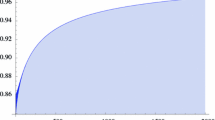Abstract
Carlitz established a q-analog of the Eulerian numbers \(A_{n,k}(q)\) and defined the relationship \(A_{n,k}(q)=q^{\frac{(n-k)(n-k+1)}{2}}A_{n,k}^{*}(q)\). In this paper, by using the combinatorial interpretation of \(A_{n,k}^{*}(q)\) and constructing injective maps, we prove that \(A_{n,k}^{*}(q)\) and \(A_{n,k}(q)\) are q-log-concave, that is, all the coefficients of the polynomials \(( A_{n,k}^{*}(q)) ^{2}- A_{n,k-1}^{*}(q) A_{n,k+1}^{*}(q) \) and \((A_{n,k}(q)) ^{2}- A_{n,k-1}(q) A_{n,k+1}(q)\) are nonnegative for \(1< k <n\).



Similar content being viewed by others
References
Butler, L.M.: The \(q\)-log-concavity of \(q\)-binomial coefficients. J. Combin. Theory Ser. A 54(1), 54–63 (1990)
Carlitz, L.: A combinatorial property of \(q\)-Eulerian numbers. Am. Math. Mon. 82(1), 51–54 (1975)
Carlitz, L.: A note on \(q\)-Eulerian numbers. J. Combin. Theory Ser. A 25(1), 90–94 (1978)
Carlitz, L.: \(q\)-Bernoulli and Eulerian numbers. Trans. Am. Math. Soc. 76(2), 332–350 (1954)
Chen, W.Y.C., Wang, L.X.W., Yang, A.L.B.: Schur positivity and the \(q\)-log-convexity of the Narayana polynomials. J. Algebraic Combin. 32(3), 303–338 (2010)
Foulkes, H.O.: A nonrecursive combinatorial rule for Eulerian numbers. J. Combin. Theory Ser. A 22(2), 246–248 (1977)
Ji, K.Q.: The \(q\)-log-concavity and unimodality of \(q\)-Kaplansky numbers. Discret. Math. 345(6), 112821 (2022)
Kurtz, D.C.: A note on concavity properties of triangular arrays of numbers. J. Combin. Theory Ser. A 13(1), 135–139 (1972)
Acknowledgements
The authors thank the anonymous referee for his/her constructive comments and helpful suggestions which have greatly improved the original manuscript.
Author information
Authors and Affiliations
Contributions
Xinmiao Liu and Jiangxia Hou wrote the main manuscript text and Fengxia Liu prepared the examaples. All authors reviewed the manuscript.
Corresponding author
Ethics declarations
Competing interests
The authors declare no competing interests.
Additional information
Publisher's Note
Springer Nature remains neutral with regard to jurisdictional claims in published maps and institutional affiliations.
This work was supported by NSFC (No. 11961067).
Appendix
Appendix
For the lattice path \(\sigma ,\ \beta ,\ w=\phi (\sigma ),\) and \(v=\phi (\beta )\) sketched in Fig. 3, we obtain
It is clear that \(P_{w}(q)P_{v}(q)-P_{\sigma }(q)P_{\beta }(q)\ge _{q} 0\) and \(P_{w}(q)P_{v}(q)-qP_{\sigma }(q)P_{\beta }(q)\ge _{q} 0\).
Rights and permissions
Springer Nature or its licensor (e.g. a society or other partner) holds exclusive rights to this article under a publishing agreement with the author(s) or other rightsholder(s); author self-archiving of the accepted manuscript version of this article is solely governed by the terms of such publishing agreement and applicable law.
About this article
Cite this article
Liu, X., Hou, J. & Liu, F. A combinatorial proof of q-log-concavity of q-Eulerian numbers. Ramanujan J (2024). https://doi.org/10.1007/s11139-024-00841-6
Received:
Accepted:
Published:
DOI: https://doi.org/10.1007/s11139-024-00841-6



